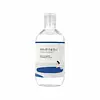What's inside
What's inside
 Key Ingredients
Key Ingredients

 Benefits
Benefits

 Concerns
Concerns

No concerns
 Ingredients Side-by-side
Ingredients Side-by-side

Water
Skin ConditioningCocamidopropyl Betaine
CleansingGlycerin
HumectantDecyl Glucoside
CleansingButylene Glycol
HumectantPropylene Glycol
HumectantCoco-Glucoside
CleansingPoloxamer 184
EmulsifyingSodium Cocoyl Glutamate
CleansingSodium Lauroyl Sarcosinate
CleansingTrehalose
HumectantHydrolyzed Pearl
Skin ConditioningCetearyl Alcohol
EmollientCaprylic/Capric Triglyceride
MaskingPhenoxyethanol
PreservativeDicaprylyl Carbonate
EmollientChondrus Crispus Extract
Skin ConditioningCodium Tomentosum Extract
Skin ProtectingFucus Vesiculosus Extract
EmollientSpirulina Platensis Extract
Skin ProtectingTocopherol
AntioxidantEthylhexylglycerin
Skin ConditioningChamomilla Recutita Flower Oil
MaskingCamellia Sinensis Leaf Oil
AntioxidantCitrus Sinensis Peel Oil Expressed
PerfumingJuniperus Virginiana Oil
MaskingOlea Europaea Fruit Oil
MaskingPrunus Amygdalus Dulcis Oil
Skin ConditioningCitric Acid
BufferingWater, Cocamidopropyl Betaine, Glycerin, Decyl Glucoside, Butylene Glycol, Propylene Glycol, Coco-Glucoside, Poloxamer 184, Sodium Cocoyl Glutamate, Sodium Lauroyl Sarcosinate, Trehalose, Hydrolyzed Pearl, Cetearyl Alcohol, Caprylic/Capric Triglyceride, Phenoxyethanol, Dicaprylyl Carbonate, Chondrus Crispus Extract, Codium Tomentosum Extract, Fucus Vesiculosus Extract, Spirulina Platensis Extract, Tocopherol, Ethylhexylglycerin, Chamomilla Recutita Flower Oil, Camellia Sinensis Leaf Oil, Citrus Sinensis Peel Oil Expressed, Juniperus Virginiana Oil, Olea Europaea Fruit Oil, Prunus Amygdalus Dulcis Oil, Citric Acid
Water
Skin ConditioningGlycerin
HumectantPropanediol
SolventGlycereth-26
HumectantPentylene Glycol
Skin ConditioningBetula Platyphylla Japonica Juice
Skin Conditioning1,2-Hexanediol
Skin ConditioningChondrus Crispus Extract
Skin ConditioningSaccharum Officinarum Extract
MoisturisingSodium Hyaluronate
HumectantHyaluronic Acid
HumectantPanthenol
Skin ConditioningTromethamine
BufferingDipotassium Glycyrrhizate
HumectantGlyceryl Caprylate
EmollientGlyceryl Glucoside
HumectantButylene Glycol
HumectantAscorbic Acid
AntioxidantCarbomer
Emulsion StabilisingXanthan Gum
EmulsifyingDisodium EDTA
Water, Glycerin, Propanediol, Glycereth-26, Pentylene Glycol, Betula Platyphylla Japonica Juice, 1,2-Hexanediol, Chondrus Crispus Extract, Saccharum Officinarum Extract, Sodium Hyaluronate, Hyaluronic Acid, Panthenol, Tromethamine, Dipotassium Glycyrrhizate, Glyceryl Caprylate, Glyceryl Glucoside, Butylene Glycol, Ascorbic Acid, Carbomer, Xanthan Gum, Disodium EDTA
 Reviews
Reviews

Ingredients Explained
These ingredients are found in both products.
Ingredients higher up in an ingredient list are typically present in a larger amount.
Butylene Glycol (or BG) is used within cosmetic products for a few different reasons:
Overall, Butylene Glycol is a safe and well-rounded ingredient that works well with other ingredients.
Though this ingredient works well with most skin types, some people with sensitive skin may experience a reaction such as allergic rashes, closed comedones, or itchiness.
Learn more about Butylene GlycolChondrus Crispus Extract comes from a red algae native to the northern Atlantic coasts of Europe and North America. It helps hydrate the skin and is rich in antioxidants.
The antioxidants in chondrus crispus include lutein and zeaxanthin. Lutein has the ability to filter blue light from screens.
Other contents of chondrus crispus include polysaccharides, peptides, and amino acids. These help hydrate the skin.
What's the difference between algae and seaweed?
Algae is a broad term that includes seaweed. Not all algae is seaweed.
Glycerin is already naturally found in your skin. It helps moisturize and protect your skin.
A study from 2016 found glycerin to be more effective as a humectant than AHAs and hyaluronic acid.
As a humectant, it helps the skin stay hydrated by pulling moisture to your skin. The low molecular weight of glycerin allows it to pull moisture into the deeper layers of your skin.
Hydrated skin improves your skin barrier; Your skin barrier helps protect against irritants and bacteria.
Glycerin has also been found to have antimicrobial and antiviral properties. Due to these properties, glycerin is often used in wound and burn treatments.
In cosmetics, glycerin is usually derived from plants such as soybean or palm. However, it can also be sourced from animals, such as tallow or animal fat.
This ingredient is organic, colorless, odorless, and non-toxic.
Glycerin is the name for this ingredient in American English. British English uses Glycerol/Glycerine.
Learn more about GlycerinWater. It's the most common cosmetic ingredient of all. You'll usually see it at the top of ingredient lists, meaning that it makes up the largest part of the product.
So why is it so popular? Water most often acts as a solvent - this means that it helps dissolve other ingredients into the formulation.
You'll also recognize water as that liquid we all need to stay alive. If you see this, drink a glass of water. Stay hydrated!
Learn more about Water